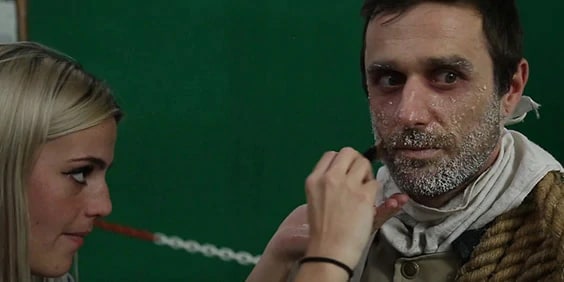What is Visual Effects? (0:12 min.)
FILM & TV
VISUAL EFFECTS SOFTWARE
Autodesk software for visual effects (VFX) professionals powers modern production pipelines.
What is visual effects?
Visual effects (VFX) is the process through which imagery is altered, created, or enhanced for live-action media that could not be captured during live-action filming due to it being costly, dangerous, impractical, or impossible to shoot. Visual effects allow for the integration of live-action footage and VFX to create realistic objects, characters and environments.
What is the difference between VFX, CGI and special effects?
Movie special effects terms are often used interchangeably but are different in that VFX are created using a combination of live action shots and digital imagery, CGI is anything created digitally, and Special Effects are captured live, without the aid of a computer.
-

VISUAL EFFECTS
VFX (visual effects) in film is a process of creating imagery that does not physically exist through the use of CGI, Compositing and Motion Capture. Examples include 3D modelling, green screen filming and performance capture.
-

CGI
(Computer-generated imagery) is anything that is created digitally within a computer. CG can be incorporated into a VFX shot in a live-action movie (i.e., The dinosaurs in Jurassic World) or used to create a fully CG film (i.e., Toy Story).
Image courtesy of Amaru Zeas
-

SPECIAL EFFECTS
SFX (special effects) are practical effects that do not use CGI. They are implemented directly on set during filming and are either mechanical or optical effects. Examples include prosthetics, miniatures, paintings, stop motion photography and animation and composite imagery.
Our VFX software
A wide range of proven and established computer-generated imagery (CGI) and VFX tools for film and TV production.
Free VFX software
FREE SOFTWARE FOR STUDENTS, EDUCATORS AND EDUCATIONAL INSTITUTIONS
We offer free Autodesk software for students and educators. Use the same visual effects software as top professionals around the world.
FREE VISUAL EFFECTS SOFTWARE FOR NONPROFITS
Are you a nonprofit or entrepreneur working to create positive impact through design? See if you qualify for our Technology Impact Program.
See how studios are using visual effects software
-
Netflix’s Lost in Space: How VFX modernized a classic franchise
Thanks to the power and remarkable malleability of VFX work, Image Engine was able to give a series as familiar as “Lost in Space” new life, reimagining 50-year-old concepts for the modern era.
Image courtesy of Image Engine
-

Double Negative talks VFX on "Thor: Ragnarok"
The rising popularity of superhero movies has brought new challenges to VFX studios. Double Negative shares their work on “Thor: Ragnorok”, the hurdles they faced, and how they tackled them.
Image courtesy of Dneg
-

My journey to "Blade Runner 2049"
Richard Hoover, VFX Supervisor at Framestore's Montreal office, shares how the studio pulled off some of the most demanding sequences filmgoers have ever seen for “Blade Runner 2049”.
Image courtesy of framestore
VFX resources
Learn more about rendering software with these tutorials, tips, and guides.
-
Tutorials of all levels to help you learn Maya, our 3D animation and modeling software
-
3D modeling and rendering software for design visualization
Tutorials of all levels to help you learn 3ds Max. -
3D visual effects (VFX), finishing, and color grading software
Tutorials of all levels to help you learn Flame. -
Global illumination rendering software
The place to ask and answer questions and share knowledge about using Arnold. -
The learning hub on AREA has free tutorials for software used by VFX professionals, ranging from beginner to advanced skill levels.
-
From big studios to independent film makers, learn more about our customers, their VFX work, and the problems they’re solving.
Frequently asked questions
Autodesk software including Maya, 3ds Max, and Flame can be used for a wide range of VFX, from sophisticated particle, liquid, and character effects to 3D compositing and finishing.
Whether you’re looking to create blazing explosions or complex snowstorms, Bifrost for Maya is a powerful visual programming environment for creating blockbuster-worthy VFX simulations, procedurally. Bifrost for Maya includes ready-to-use graphs, physically-based solvers for aerodynamics, combustion, granular effects, and cloth simulation, and more.
Look to VFX software from Autodesk for the support you need to help your teams work quickly and create stunning visual effects. Bifrost for Maya’s prebuilt graphs allow you to create realistic effects right out of the box. Autodesk Arnold is integrated with Maya and 3ds Max, so you can see high-quality previews and iterate changes quickly. Flame 3D VFX and finishing software provides powerful tools for 3D compositing, visual effects, and editorial finishing.
Autodesk software is engineered to streamline collaboration throughout the VFX pipeline by connecting creative workflows and teams. ShotGrid production management software integrates with Maya, 3ds Max, and Flame enabling creative teams to seamlessly submit work for reviews, collaborate, and iterate on changes – even while geographically dispersed.
Autodesk Arnold is the default renderer in Maya and 3ds Max, allowing you to keep your rendering workflows right in-tool. Arnold is an advanced Monte Carlo ray tracing renderer that offers a powerful rendering experience for beautiful and predictable results. Visualize changes to lighting, textures, and objects, adjust cameras, and diagnose problems without ever leaving your 3D tool.
3ds Max and Maya are both used by creative studios around the world for animation, modeling, visual effects, and rendering. 3ds Max offers a robust toolset for modeling, intuitive texturing and shading, and high-quality rendering while Maya offers powerful tools for character creation, lifelike animation, and detailed simulations. Read more about the differences between 3ds Max and Maya.